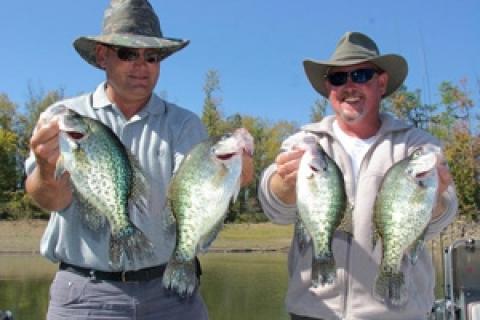
Autumn fishing frustrates many crappie anglers. During fall, America's favorite panfish often are scattered and hard to find. Crappie may be deep one day, shallow the next and suspended at mid-depths the next. Fish may feed ravenously in the morning and get a bad case of lockjaw in the afternoon.
 On the lakes and reservoirs usually targeted by crappie anglers, crappie typically stay in or near the thermocline. Shallow-water action might be good during cool, low-light periods, but crappie rarely venture to the "dead zone" below the thermocline. For this reason, pinpointing schools of summer fish is relatively simple; find the cool, oxygen-rich water that forms the thermocline and you'll find crappie.
On the lakes and reservoirs usually targeted by crappie anglers, crappie typically stay in or near the thermocline. Shallow-water action might be good during cool, low-light periods, but crappie rarely venture to the "dead zone" below the thermocline. For this reason, pinpointing schools of summer fish is relatively simple; find the cool, oxygen-rich water that forms the thermocline and you'll find crappie.
This changes when fall begins. Cool weather begins lowering the surface water temperature. As the upper layer cools, it becomes heavier and sinks. This action forces warmer, lighter water back to the surface. This water subsequently is cooled, just as the previous surface layer was, and descends as it cools. This mixing or "turnover" continues several weeks until the thermocline disappears and all water in the lake is roughly the same temperature. This mixing effect also replenishes oxygen in deep water.
![]() Tip: Crappie Facs: The Highs and Lows of Crappie Fishing (infographic)
Tip: Crappie Facs: The Highs and Lows of Crappie Fishing (infographic)
Crappie Can Now Move to Deeper Water
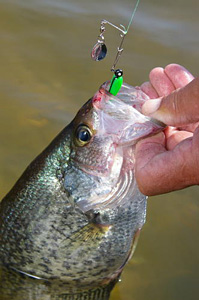 |
| Small lures fished on light line are among the best options as turnover waters clear and crappie move deeper. |
The end result is that fish formerly restricted to narrow bands of acceptable oxygen and temperature no longer are limited in their movements. Crappie once barred from the coolest depths because of low oxygen levels now may roam freely to much deeper water. Likewise, where once fish could not spend extended periods in extreme shallows due to high temperatures and low oxygen levels, after turnover, even these areas are acceptable. Crappie may now be found deep, shallow or anywhere in between.
Some waters don't experience turnover because they don't stratify in summer. Rivers are a case in point. So are many large, shallow, windswept lakes and some reservoirs with lock-and-dam facilities or hydroelectric generators.
In waters where fall turnover does occur, however, the angler will need to dig deep into his or her bag of tricks in order to zero in on schools of crappie. And it never hurts to have a few new fishing tricks in your bag. Here are some that could help.
Finding the Crappie Fishing Comfort Zone
The secret to crappie-fishing success — regardless of the season — is realizing crappie always concentrate in areas providing the most comfortable living conditions and learning to identify those areas. In fall, conditions are theoretically such that crappie can live anywhere within the lake. In actuality, factors such as oxygen content, light penetration and food availability still greatly influence a crappie's choice of living quarters.
Consider, for example, that all the debris and poorly oxygenated water being pushed upward from the lake bed when turnover begins temporarily "trashes" the whole system. Crappie respond by seeking areas with good quality water. To find them, savvy anglers do likewise. An easy way is working tributaries bringing fresh water into the lake. Another way is looking for areas where turnover has not begun. On some large reservoirs, different arms turn over at different times; anglers can concentrate their efforts in areas that aren't visibly affected. 
When turnover causes excessive amounts of decaying debris to circulate in the water column, sudden significant drops in oxygen can result. When this happens, crappie must find oxygenated water immediately. They frequently solve the problem by going directly to the nearest source, which is surface aeration from wind and waves. Consequently, windswept shorelines with shallow cover may be productive crappie fishing spots.
Your first order of business when fishing during the turnover period should be finding comfort zones such as those just described and working them systematically to pinpoint crappie.
![]() TIP: 4 Tips for Sight-Fishing Crappie
TIP: 4 Tips for Sight-Fishing Crappie
Try Fishing Standing Timber
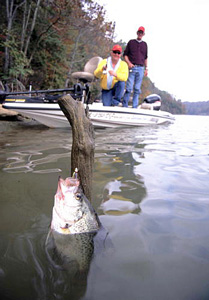 |
| Crappie often concentrate around standing timber as turnover ends and the water starts clearing. |
When turnover ends and the water starts clearing, crappie often concentrate around standing timber. Here the fish can move shallow or deep as water and weather conditions dictate. On cloudy or windy days when light doesn't penetrate very far into the water, crappie may be within a few feet of the surface. Bright, sunny, post-frontal days may find them hugging the bottom. Adjust your tactics accordingly.
"When fishing standing timber, fish each tree for only a couple of seconds," says Missouri crappie pro Kevin Rogers whose specialty is jigging vertical timber. "If you don't get a bite, move to the next tree. Too many people make the mistake of sitting or tying up to a tree. You'll catch more fish by using your trolling motor and moving from tree to tree."
Rogers has used such tactics to qualify for the Crappie USA Classic during six consecutive years. The way you present your lure, he says, is important.
"When vertical jigging around standing timber, after your lure reaches the bottom, grab the line with your free hand and gently raise the lure up the tree," he says. "Crappie will not go down to hit your bait so raising the lure puts the bait in their face. They can't stand it"
Dealing With Cold Fronts
Passing cold fronts are a common fall phenomenon. And when a front moves in, the fishing can quickly turn sour. Crappie still can be caught, however, if the angler knows how to deal with this situation.
"Anglers can't control the weather," says Kentucky crappie guide Steve McCadams. "But they can adjust their presentation and be more effective in catching crappie when weather patterns turn nasty. I've seen crappie have a drastic mood swing literally overnight when cold fronts descend, lowering surface temperatures with bone-chilling winds. After the front passes, high skies with a high-pressure system alter the crappies' feeding habits, too."
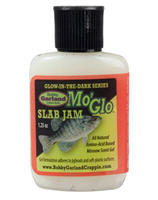 |
| Bobby Garland Mo' Glo Slab Jam |
Crappie relate close to structure in this scenario, says McCadams.
"To catch them, you must slow down your presentation to a vertical style, keeping the bait in front of the fish longer and in their specific depth range," he notes. "Don't expect the fish to be aggressive and chase down a moving bait because they're holding tight on structure. Light or small lure sizes will help too, as will using a bobber for slow, sinking presentations that assist you in keeping the bait in the strike zone longer."
Selecting Crappie Lures/Baits
In fall, as during other seasons, lure selection depends primarily on water and weather conditions, available forage and the physical characteristics of the area you're fishing. Remembering these tips should help you make the best selection.
- If visibility is restricted due to circulating debris, crappie rely more on sound, vibrations and odor to find food. Using lures with rattles, flashy spinners, spray-on scent or liquid crappie attractants like the Bobby Garland Mo' Glo Slab Jam and other such attention-getters may improve success.
-
Because crappie in stained water move in tighter on cover, work jigs and minnows closer than usual to cover in dingy water. Bumping the cover may be necessary to elicit strikes.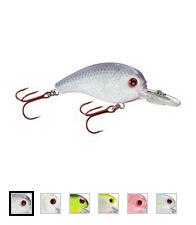
Bass Pro Shops Crappie Maxx Crank - As turnover waters clear, crappie move deeper. That's when it's time to use small lures fished on light line. Small jigs, spoons, bladebaits and crappie plug lures like the popular Bass Pro Shops Crappie Maxx Crank are among the best.
- Don't depend only on lures. A shiner minnow rigged to remain lively is one of the best crappie attractors during turnover. Smart anglers carry a variety of lures and a good supply of minnows when fishing this time of year.
![]() TIP: 3 Reasons to Fish Bladed Jigs for Fall Crappie
TIP: 3 Reasons to Fish Bladed Jigs for Fall Crappie
Additional Tips for Fall Fishing
-
Spider trolling and drifting are excellent ways to pinpoint scattered schools of autumn crappie. Rig several poles with different lures/baits set at different depths, then move around in likely looking areas. When you catch a fish, change rigging so all your poles conform to the depth and bait preferences exhibited by that fish.
Crappie lure selection depends primarily on water and weather conditions, available forage and the physical characteristics of the area you're fishing. - Fall crappie often follow secondary bottom channels when moving between deep water and shallow. A marine sonar fish finder unit is invaluable for pinpointing this type of structure and the fish themselves.
- Jigs and minnows are the best crappie baits year-round, but if one or the other doesn't produce, try a jig/minnow combo. A marriage of live bait and artificial lure sometimes does the trick for finicky fall crappie.
- Be patient and persistent. Fall conditions force fish to roam, thus fishermen must also be willing to move frequently, forsaking likely looking spots or those that produced yesterday. If the tactics covered here don't produce crappie, improvise another strategy and keep trying.
In Conclusion
The transition from summer to autumn is jolting for both fish and fishermen. Crappie find their once secure world literally turned over on them. Anglers who fish these waters find their quarry more unpredictable than ever. Overcoming this seasonal nemesis will require all the skill, knowledge and patience you can muster. But when you finally zero in on a big school of hefty autumn crappie, you're sure to agree that the rewards make the extra effort worthwhile.
- 61611 views



